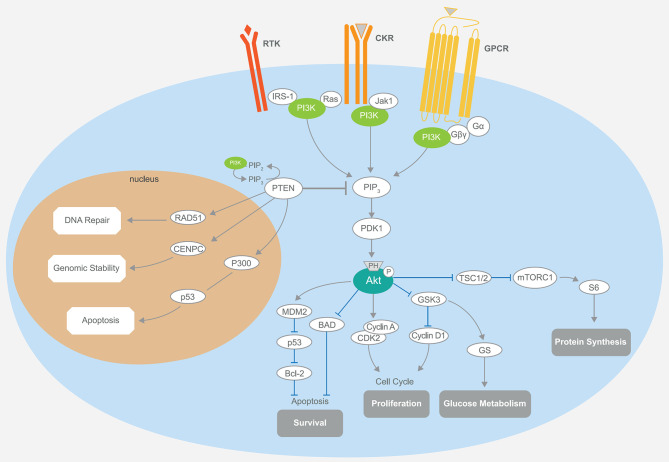Figure 1.
Schematic representation of the PI3K/Akt/mTOR signaling and its main components. The PI3K pathway regulates diverse cellular processes, including protein synthesis, cell survival, proliferation, glucose metabolism, apoptosis, DNA repair, and genome stability. Akt-mediated phosphorylation inhibits the activity of the TSC1–TSC2 complex, also known as hamartin-tuberin. This is a critical step for the negative regulation of mTORC1, whose activity controls anabolic processes. Another important downregulation of Akt phosphorylation is toward BAD, while MDM2 activity is enhanced, promoting the degradation of the tumor-suppressor p53, which also plays a part in the P300-mediated cell apoptosis. Cell cycle regulation occurs through the stimulation of cyclins A and D and the inhibition of GSK3. The latter event is also responsible for increased glucose metabolism. PTEN is intimately involved in the regulation of these mechanisms through its substrate PIP3. Notably, the activity of PTEN in the cell nucleus that leads to cell survival control is related to the upregulation of key mediators, such as RAD51, CDNPC, and P300. RTK, receptor tyrosine kinase; CKR, chemokine receptor; GPCR, G protein-coupled receptor; IRS-1, insulin receptor substrate 1; PI3K, phosphatidylinositol-3 kinase; JAK1, Janus kinase 1; PIP3, phosphatidylinositol-3,4,5-trisphosphate; PDK1, pyruvate dehydrogenase lipoamide kinase isozyme 1; TSC, tuberous sclerosis complex; mTORC1, mammalian target of rapamycin complex 1; MDM2, mouse double minute 2 homolog; BAD, BCL2 associated agonist of cell death; GSK3, glycogen synthase kinase-3; CDK2, cyclin-dependent kinase 2; CDNPC, centromere protein C.

